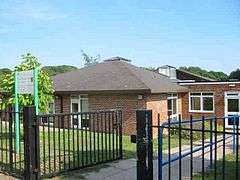Bricket Wood
Bricket Wood is a village in the county of Hertfordshire, England, 4.2 miles (6.8 km) south of St Albans and 4.2 miles (6.8 km) north-northeast of Watford.
| Bricket Wood | |
|---|---|
 Bricket Wood Common south of the town/village | |
 Mount Pleasant Lane JMI School | |
 Bricket Wood Location within Hertfordshire | |
| Population | 4,095 (2001) |
| OS grid reference | TL135025 |
| Civil parish | |
| District |
|
| Shire county | |
| Region | |
| Country | England |
| Sovereign state | United Kingdom |
| Post town | ST ALBANS |
| Postcode district | AL2 |
| Dialling code | 01923 |
| Police | Hertfordshire |
| Fire | Hertfordshire |
| Ambulance | East of England |
| UK Parliament | |

Civil organisation and notable buildings
It is part of the archaically named civil parish of St Stephen, as there is no church connection to its affairs as the third tier of local government. It is in the St Albans district who share provision of local government services with Hertfordshire County Council.
It is in that of the civil parish of St. Stephen.
Bricket Wood railway station is served by a West Midlands Trains service that runs between St Albans Abbey and Watford Junction; the service is stopping and both towns are three stops away with a frequent service. This historic building was taken into private ownership in 2018, and is being developed into a sympathetic recreation of its original appearance. It will be a village hub and meeting room, as well as a station.
The local primary school is Mount Pleasant Lane, situated in grounds that include a small pond.
Close to the village stands Hanstead House, built by Sir David Yule in 1925, who is buried in the grounds. It formerly operated as a horse-breeding farm, as an American evangelical college, and as a corporate training centre. It is now being developed for housing.
St Luke's Church is the Anglican place of worship, a unique building designed to look like an upside down boat. It was based on Noah's Ark.
The village is known for its bungalows.
History
The area of Bricket Wood was mostly occupied by farmers until Bricket Wood train station was built in 1861. In 1889 brothers Henry Gray and William Gray bought up land in the area and built Woodside Retreat Fairground. The fairground attracted hordes of visitors to the area from London and nearby towns and a small village developed around the station. In 1923, a rival fairground named Joyland was built nearby by R.B Christmas. Both resorts were closed in 1929, Christmas used his leftover land for building bungalows.
During the 1930s the area became popular with naturists after Charles Macaskie set up the naturist camp Spielplatz on the outskirts of the village. Naturists bought up plots of land on the edge of the village and built their own communities, which at first didn't have electricity or running water. The village also began to attract Wiccans after Gerald Gardner set up Bricket Wood coven.
During the 1950s housing estates were built for employees of aviation company Handley Page, who had a plant nearby. More estates then followed, aimed at commuters desiring housing near the Green Belt with convenient access to London.
Morris Dancing
The village is home to the border Morris Dancing team Wicket Brood, one of the best known teams in the area.
Common
Bricket Wood Common is a 70 hectare Site of Special Scientific Interest.
Notable residents
- Frank Turner (1922-2010), three-time Olympic gymnast, died at his home in the village.
- Ralph Coates, footballer who played for England and Tottenham Hotspurs, lived in the village until his death in December 2010
| Wikimedia Commons has media related to Bricket Wood. |
References
External links
Bricket Wood Facebook Group. A Facebook group for people with an interest in the Hertfordshire village of Bricket Wood.